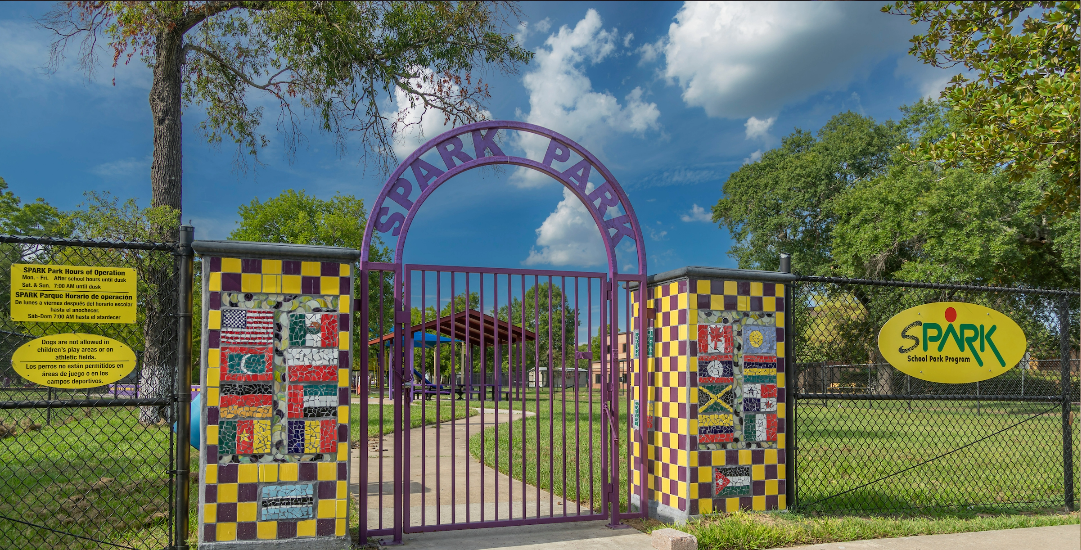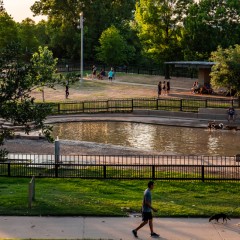Forty years later, the initiative founded by former Houston City Council member Eleanor Tinsley has built more than 200 accessible, affordable community spaces in Harris and Fort Bend counties. There are an additional 10 parks in planning or construction that will be dedicated in May 2024.
This year the nonprofit is commemorating its 40th anniversary by announcing the third phase of its Park Desert Initiative, which seeks to bring parks to communities where residents are at least a 10-minute walk or half-mile away from a park. The initiative has raised $8 million from The Brown Foundation, Houston Endowment and the Kinder Foundation. Spark hopes to raise another $2 million from private foundations and individuals.
As recent Kinder Institute research indicated, Houston’s park landscape has benefited immensely from private philanthropy and public-private partnerships like SPARK. In fact, Houston parks received more private funding than any other metro besides New York City in 2022, according to data compiled by the Trust for Public Land.
The Urban Edge spoke with Kathleen Tinsley Ownby, executive director of the SPARK School Park Program and Eleanor’s daughter, to discuss the history and future of SPARK Parks. The interview has been edited for length and clarity.
Looking across the U.S., how unique is the SPARK program?
The idea has grown more popular through the years with the City Parks Alliance; the National League of Cities, Children & Nature Network; Trust for Public Land; and other groups emphasizing the greenspace that the public already owns at public school grounds but is often not utilized after school hours. Other cities like New York, Chicago and Denver have joined the green schoolyard bandwagon. Now, across the U.S., it is a popular way to increase park space. There is a green schoolyards bill that is gaining momentum at the federal level.
How do SPARK Parks encourage community involvement and collaboration with local artists?
At our first site visit with the principal, we ask that a SPARK Committee be formed of teachers, parents and community members to work with a landscape architect on the design of their park and on fundraising. Each school is given a goal of raising $5,000. Some schools collect a lot of pennies to make that goal; other schools have strong parent-teacher organizations or even foundations that raise hundreds of thousands of dollars.
One of our first major public art projects was at Travis Elementary School in the Woodland Heights area of Houston. There were several architects, landscape architects and artists living in the neighborhood and they were excited about artwork in the park. The students were asked to draw pictures of what they would like to see in their park. A surprise to everyone was that dinosaurs appeared in many of the drawings — this was before “Jurassic Park” and the dinosaur craze. The students had evidently just studied a unit on dinosaurs. Local artist Paul Kittelson was recruited to create the “Travisaurus.” At the groundbreaking ceremony, the students dug up dinosaur bones.
How do you determine which communities need a SPARK Park?
SPARK uses a geographic information system-based mapping tool created by the Trust for Public Land. There are several schools across Houston that are in areas deemed to be “park deserts,” meaning that there is not another city, county or SPARK Park within a 10-minute walk for residents. It would help the city’s park score and benefit the community if we could put a SPARK Park at these school locations.
What are your hopes for the SPARK School Park Program in the coming decades?
SPARK plans to continue working with public schools to develop their playgrounds into community parks. The pandemic brought this lesson home, that greenspace is valued by communities. SPARK has always been focused on park equity, reaching all areas of the Greater Houston region, and we will continue to focus on this priority. Incorporating nature-based play and natural elements within the park, especially wildflowers, native plants and vegetable gardens, is increasingly a desired element. SPARK aims to highlight these components and design them for use in school curriculum. We will also continue to work with select artists who create art for public spaces, which make the parks even more inviting.
Click here for more information about the SPARK School Park Program.



